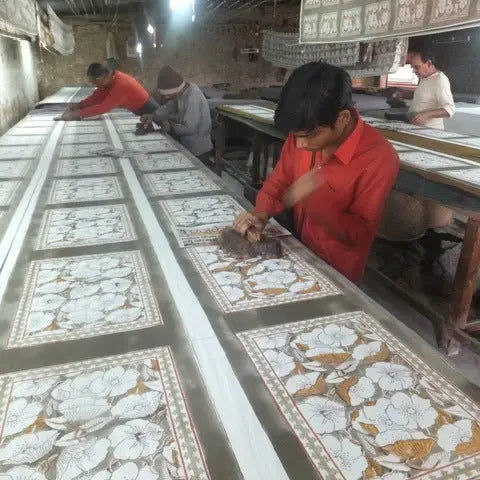Block Printing in India with Wooden Blocks and Natural Dyes
Discover the ancient Indian art of block printing with wooden blocks in textile art, using natural dyes for fabric to create unique textiles. Explore regional styles of block printing like Sanganeri and Bagru in Rajasthan.

```html
Block printing in India is an ancient, hand-crafted textile art that involves stamping cloth with finely carved wooden blocks, often using natural dyes.
🏺 A Legacy Carved in Wood
Origins: This intricate art form, where textiles are adorned with beautiful block prints, can be traced all the way back to the Indus Valley period (3500–1300 BC). It later really flourished and gained royal favor under the Mughals, becoming a significant part of India's artistic heritage.
🎨 Regional Styles & Techniques
India is home to numerous regional styles, each with its own traits, showcasing the diverse applications of block printing:
Sanganeri (Rajasthan): Known for its delicate floral and paisley motifs in vibrant red and yellow, often printed with wooden blocks directly onto white fabric. It’s like painting with stamps!
Bagru (Rajasthan): This style stands out with its bold patterns, traditionally crafted by the Chhipa community. They master the mud-resist (dabu) technique, where a special mud paste protects areas of the fabric before dyeing. Once the fabric is dipped in rich natural dyes like indigo, madder, and iron, the resist material is washed away, revealing stunning, intricate patterns.
Ajrakh (Gujarat/Rajasthan): You'll recognize Ajrakh by its distinctive geometric and floral designs in deep indigo and crimson. This technique also uses resist dyeing, often incorporating natural dyes made from pomegranate, turmeric, and myrobalan to achieve its rich, earthy palette.
Dabu (Rajasthan): A specific resist method that involves applying a unique mud paste before dyeing. This process results in beautiful, earthy, and layered designs that are truly one-of-a-kind.
Bagh (Madhya Pradesh): Produced in the village of Bagh, this style uses local water and natural pigments to create stunning red and black floral and geometric patterns. It's a wonderful example of how regional resources shape artistic expression.
Kalamkari (Andhra/Telangana): This beautiful style uniquely combines block printing with freehand painting, often depicting mythological scenes and intricate narratives that tell a story on fabric.
🧵 The Block Printing Process
-
Block carving: The magic begins with skilled artisans who hand-carve hardwood blocks, typically from sheesham or teak wood, creating exquisite and detailed designs that will eventually transfer to the fabric.
-
Dyeing & preparation: Before printing, fabrics are carefully pre-treated. This often involves washing and, for certain styles, resist-stenciling with mud or wax to create areas that won't absorb dye.
-
Stamping: This is where the artistry truly comes alive. The carved wood blocks are dipped in vibrant natural dyes and then meticulously stamped onto the fabric in repeating patterns, building up the design layer by layer.
-
Resist dyeing (in some styles): To achieve those rich, multi-dimensional effects, fabrics in some block printing styles go through multiple cycles of resist application (with mud and/or wax) and subsequent dyeing. This creates incredible depth and complexity in the final textile.
-
Finishing: After the dyeing and printing are complete, the fabrics are carefully dried and washed. They may also be steamed or ironed to ensure the colors are beautifully set and long-lasting, ready for their new life.
🌱 Cultural Significance & Modern Revival
Symbolic designs: Beyond just aesthetics, the patterns often feature local flora, fauna, ancient folk tales, or sacred religious symbols. This means each piece of fabric is not just beautiful, but also a woven narrative, embedding deep cultural stories and traditions.
Protected traditions: To safeguard these invaluable art forms, many regional styles of block printing have earned Geographical Indications (GI) status. This is super important because it protects the artisanal identity and guarantees the authenticity and quality of these handmade textiles, much like a trademark.
Contemporary resurgence: Today, there's a fantastic resurgence of interest in block printing. Designers and conscious consumers worldwide are increasingly embracing these sustainable, handcrafted textiles, appreciating their unique charm and the stories they tell.
🎯 Why It Matters Today
Eco-conscious craftsmanship: One of the biggest draws is that many artisans continue to use eco-friendly, natural dyes for fabric. These traditional dyes are not only vibrant but also gentle on the environment, making block-printed textiles a truly sustainable choice.
Living heritage: This art form is more than just a craft; it's a vibrant cultural practice. It's living history, passed down through generations, keeping ancient techniques and stories alive in every beautifully printed piece.
Global appeal: Block-printed fabrics are incredibly well-loved worldwide! You can find them adorning fashionable clothes, adding unique flair to home decor, and inspiring collaborative artistic projects across the globe. Their distinctive charm and handmade quality truly resonate with people everywhere.
```

